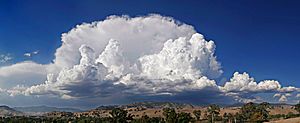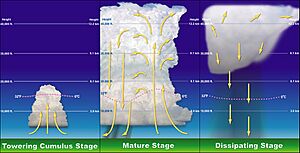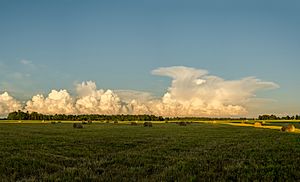Cumulonimbus cloud facts for kids
A cumulonimbus cloud is a huge, tall cloud that brings thunderstorms. Its name comes from Latin words: "cumulus" means "heap," and "nimbus" means "rainstorm" or "storm cloud." These clouds form when strong air currents carry a lot of water vapor high into the sky.
When you see a storm, these clouds are often called "thunderheads." Cumulonimbus clouds can appear alone, in groups, or in long lines, often along cold fronts. They are known for causing lightning and other serious weather, like tornadoes. They start as smaller cumulus congestus clouds and can grow into even bigger, more powerful supercell storms. You might see them shortened to Cb.
What They Look Like
Cumulonimbus clouds are very tall and often have smaller cumulus clouds around them. The bottom of a cumulonimbus cloud can spread out for many miles. It can be low in the sky or reach up to middle heights.
The tops of these clouds can reach as high as 40,000 feet (about 12 kilometers). In extreme cases, they can go up to 70,000 feet (about 21 kilometers) or even higher! Well-developed cumulonimbus clouds often have a flat, anvil-shaped top. This shape is caused by strong winds high in the atmosphere. You might even see lightning flash from the anvil part of the cloud. Even a small cumulonimbus cloud looks huge compared to other clouds nearby.
What They Cause
Cumulonimbus storm clouds can bring very heavy rain. This rain often falls in a concentrated area, sometimes causing flash floods. They can also create strong, straight-line winds called downbursts. Most storm cells usually disappear after about 20 minutes.
However, if there is a lot of solar energy in the atmosphere (like on a hot summer day), the moisture from one storm can quickly evaporate. This can cause a new storm cell to form nearby. Because of this, thunderstorms can sometimes last for several hours.
Cumulonimbus clouds can also cause dangerous winter storms, known as "blizzards." These blizzards can bring lightning, thunder, and very heavy snow. While they can happen in winter, cumulonimbus clouds are most common in warmer, tropical areas.
Images for kids
-
Cumulonimbus calvus cloud in Monterrey, Mexico.
See also
 In Spanish: Cumulonimbus para niños
In Spanish: Cumulonimbus para niños




















